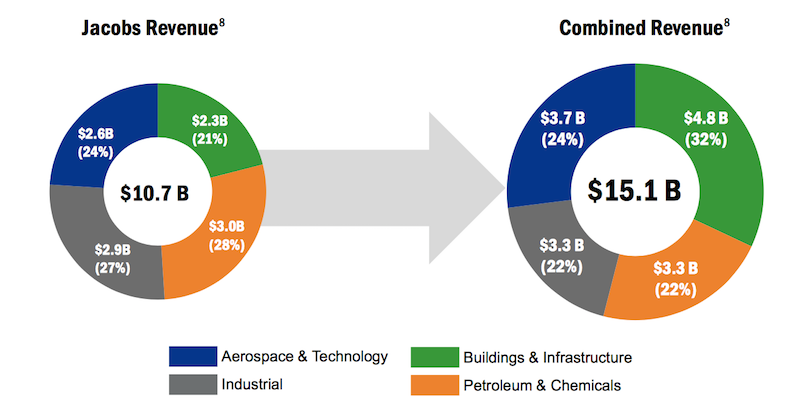Jacobs Engineering Group has entered into a definitive agreement to acquire the outstanding shares of CH2M Hill Companies, an Englewood, Colo.-based consulting and program management firm that is a leader in infrastructure, environmental, and government sectors.
Dallas-based Jacobs will finance this deal, valued at $3.27 billion (including assumption of $416 million of CH2M debt), with 60% cash and 40% stock. The firm has secured financing, including a $1.2 billion three-year term loan.
The acquisition is expected to close by the first quarter of 2018. It is subject to approval by CH2M’s shareholders that would own 15% of Jacobs’ stock upon consummation.
Jacobs is already a major player in the oil and chemicals sectors as a consultant, engineer, and project manager. Its other specialties include construction, aerospace, and defense.
In CH2M, Jacobs is acquiring a 71-year-old firm that is a leader in such areas as water infrastructure, transportation, industrial manufacturing, and environmental services.
CH2M, with more than 20,000 associates, is employee owned. It generates about $4.4 billion in annual revenue, with 73% of its business coming from consulting and program management. More than 70% of its clientele is local, state, or federal governments. Its adjusted cash flow, as of June 2017, was $323 million.
The combined company’s $15.1 billion in revenue could challenge AECOM as the world’s largest engineering firm, at a time when the Trump Administration has proposed, in general terms, an infrastructure construction and repair program in the U.S. that would include $1 trillion in public and private funding over a decade.
The combined company would be more heavily weighted toward building and infrastructure than Jacobs is currently. And the combination would surpass AECOM in global design revenue ($10 billion vs. $7.4 billion).

Buildings & Infratstructure would be a bigger part of Jacobs' portfolio if its merger with CH2M goes through. Image: Jacobs
“This is a major milestone for Jacobs and the industry,” proclaimed Steve Demetriou, Jacobs’ Chairman and CEO, during a webcast to provide analysts with details about the agreement. Demetriou was joined by Bob Pragada, President of Jacobs’ Buildings and Infrastructure & Industrial business unit; and Kevin Berryman, the firm’s EVP and CFO.
None of CH2M’s corporate officials participated in the webcast, and it’s not clear who from CH2M’s C-Suite would be staying on, or whether Jacobs intended to use CH2M’s brand for marketing purposes.
Demetriou did say, though, that one of Jacobs’ top priorities is “retaining talent,” and that the combination would create “career development opportunities” for the combined company’s employees. He also stated that it was not Jacobs’ intention to simply fold CH2M into its operations, but to take advantage of each company’s strengths to become “a premier end-to-end global solutions provider.”
Jacobs has formed an Integration Management Office, led by Gary Mandel and Lisa Glatch, EVPs with Jacobs and CH2M, respectively. The firm has also hired an outside consultant (which it did not identify during the webcast) to assist the merger. Demetriou will chair an executive steering committee set up to ensure a smooth transition and integration.
Another priority is to deliver cost and cost synergies. Jacobs executives made the point several times that there is minimal overlap in Jacobs’ and CH2M’s clientele and markets, and that both companies have pursued relatively low-risk business strategies that focus on profitability and margins. Pragada pointed specifically to Buildings, Infrastructure, Aerospace, and Technology as “higher margin” sectors that the combined company would pursue.
However, there will be streamlining if this deal goes through. Berryman said Jacobs projects this combination to produce $150 million in annual cost savings by its second full year. Berryman said “at least” 50 of the two firms’ locations worldwide present “combination opportunities.”
During the webcast, some analysts expressed skepticism about this merger, based on past AEC deals that didn't pan out as advertised, and on the fact that this deal makes Jacobs more design oriented.
Executives at Jacobs—which during its history has acquired more than 70 companies—countered that this deal has undergone extensive due diligence of all of CH2M’s projects. More to the point, they said the acquisition is a good fit for Jacobs’ broader three-year strategic growth initiative that began last year.
Demetriou assured analysts that his company has “the accountable leadership in place” to execute the CH2M deal, and to “create a new industry leader and stronger partner.”
Related Stories
Mass Timber | Jun 17, 2024
British Columbia hospital features mass timber community hall
The Cowichan District Hospital Replacement Project in Duncan, British Columbia, features an expansive community hall featuring mass timber construction. The hall, designed to promote social interaction and connection to give patients, families, and staff a warm and welcoming environment, connects a Diagnostic and Treatment (“D&T”) Block and Inpatient Tower.
Concrete Technology | Jun 17, 2024
MIT researchers are working on a way to use concrete as an electric battery
Researchers at MIT have developed a concrete mixture that can store electrical energy. The researchers say the mixture of water, cement, and carbon black could be used for building foundations and street paving.
Codes and Standards | Jun 17, 2024
Federal government releases national definition of a zero emissions building
The U.S. Department of Energy has released a new national definition of a zero emissions building. The definition is intended to provide industry guidance to support new and existing commercial and residential buildings to move towards zero emissions across the entire building sector, DOE says.
Multifamily Housing | Jun 14, 2024
AEC inspections are the key to financially viable office to residential adaptive reuse projects
About a year ago our industry was abuzz with an idea that seemed like a one-shot miracle cure for both the shockingly high rate of office vacancies and the worsening housing shortage. The seemingly simple idea of converting empty office buildings to multifamily residential seemed like an easy and elegant solution. However, in the intervening months we’ve seen only a handful of these conversions, despite near universal enthusiasm for the concept.
Healthcare Facilities | Jun 13, 2024
Top 10 trends in the hospital facilities market
BD+C evaluated more than a dozen of the nation's most prominent hospital construction projects to identify trends that are driving hospital design and construction in the $67 billion healthcare sector. Here’s what we found.
Affordable Housing | Jun 12, 2024
Studio Libeskind designs 190 affordable housing apartments for seniors
In Brooklyn, New York, the recently opened Atrium at Sumner offers 132,418 sf of affordable housing for seniors. The $132 million project includes 190 apartments—132 of them available to senior households earning below or at 50% of the area median income and 57 units available to formerly homeless seniors.
Lighting | Jun 10, 2024
LEDs were nearly half of the installed base of lighting products in the U.S. in 2020
Federal government research shows a huge leap in the penetration of LEDs in the lighting market from 2010 to 2020. In 2010 and 2015, LED installations represented 1% and 8% of overall lighting inventory, respectively.
Libraries | Jun 7, 2024
7 ways to change 'business as usual': The Theodore Roosevelt Presidential Library
One hundred forty years ago, Theodore Roosevelt had a vision that is being realized today. The Theodore Roosevelt Presidential Library is a cutting-edge example of what’s possible when all seven ambitions are pursued to the fullest from the beginning and integrated into the design at every phase and scale.
Education Facilities | Jun 6, 2024
Studio Gang designs agricultural education center for the New York City Housing Authority
Earlier this month, the City of New York broke ground on the new $18.2 million Marlboro Agricultural Education Center (MAEC) at the New York City Housing Authority’s Marlboro Houses in Brooklyn. In line with the mission of its nonprofit operator, The Campaign Against Hunger, MAEC aims to strengthen food autonomy and security in underserved neighborhoods. MAEC will provide Marlboro Houses with diverse, community-oriented programs.
Airports | Jun 3, 2024
SOM unveils ‘branching’ structural design for new Satellite Concourse 1 at O’Hare Airport
The Chicago Department of Aviation has revealed the design for Satellite Concourse 1 at O’Hare International Airport, one of the nation’s business airports. Designed by Skidmore, Owings & Merrill (SOM), with Ross Barney Architects, Juan Gabriel Moreno Architects (JGMA), and Arup, the concourse will be the first new building in the Terminal Area Program, the largest concourse area expansion and revitalization in the airport’s almost seven-decade history.

















